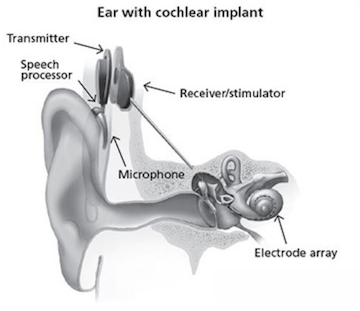Cochlear implant information for families
What is a cochlear implant?
A cochlear implant is a medical device approved by the Food and Drug Administration for the treatment of sensorineural hearing loss.
The device consists of an external speech processor, which is worn behind the ear or on the head, and a surgically implanted electrode array. It works by bypassing the hair cells in your child’s inner ear that are not functioning properly.
A cochlear implant is a safe and proven medical treatment that provides hearing to infants, children and teenagers with severe to profound hearing loss when hearing aids are not able to help. A cochlear implant does not restore your child’s natural hearing but instead provides a new way of hearing for your child. Cochlear implants are also approved for adults.
What does it look like and how does it work?

The speech processor is worn on the outside of the ear, much like a hearing aid. It has a magnet inside the receiver that attaches it to the internal device, which also has a magnet. The receiver/stimulator is surgically placed beneath the skin, and the attached electrode array is place in the inner ear.
The microphone on the speech processor picks up the sound. The speech processor codes the sounds to send across the skin with the help of thetransmitter. The sound travels to the receiver/stimulator where it is changed into electrical impulses. These impulses are sent to the electrode array inside the inner ear and stimulate the hearing nerve which allows sound to be received by the brain for interpretation.
What can cochlear implants do for my child?
With appropriate follow-up, your child will have more access to sound with cochlear implants than with hearing aids. Although there is no way for us to guarantee or predict how well a child will do with a cochlear implant, research has shown that children can develop normal speech and language using a cochlear implant. Many factors, including parental involvement, school placement, developmental ability, age at implantation, previous experience with sound, and other things we may not understand can affect a child’s ability to interpret the sound they hear from the cochlear implant.
View Cochlear implant postop education.
Are there alternatives?
Yes, your child may continue to use power hearing aids. They may supplement their hearing with sign language or use sign language as their only means of communication. All parents and guardians of deaf children should be aware of Deaf culture. This offers an alternative lifestyle in which hearing is neither valued nor necessary. Between 200,000 and 500,000 Deaf individuals in the United States communicate primarily through American Sign Language (ASL). Information about the Deaf Community is best obtained from culturally Deaf persons.